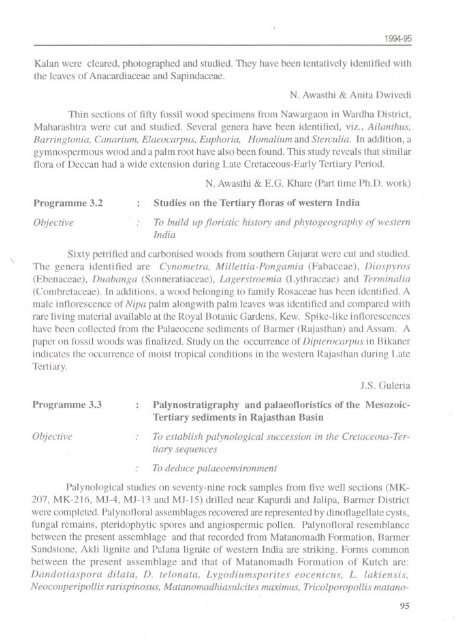1994-95 - Birbal Sahni Institute of Palaeobotany
1994-95 - Birbal Sahni Institute of Palaeobotany
1994-95 - Birbal Sahni Institute of Palaeobotany
Create successful ePaper yourself
Turn your PDF publications into a flip-book with our unique Google optimized e-Paper software.
<strong>1994</strong>-<strong>95</strong><br />
Kalan were cleared, photographed and studied. They have been tentatively identified with<br />
Ule leaves <strong>of</strong> Anacardiaceae and Sapindaceae.<br />
N. Awasthi & Anita Dwivedi<br />
Thin sections <strong>of</strong> fifty fossil wood specimens from Nawargaon in Wardha District,<br />
Maharashlra were cut and studied. Several genera have been identified, viz., Ailanthus,<br />
Harringtonia, Canarium, Elaeocarpus, Euphoria, Homalium and Sterculia. In addition, a<br />
gymnospermous wood and a palm root have also been found. This study reveals that similar<br />
tlora <strong>of</strong> Deccan had a wide extension during Late Cretaceous-Early Tertiary Period.<br />
N. AwasUli & E.G. Kharc (Pm1 time Ph.D. work)<br />
Programme 3.2<br />
Objective<br />
Studies on the Tertiary 110ras <strong>of</strong> western India<br />
To build up floristic history and phytogeography <strong>of</strong> western<br />
India<br />
Sixty petrified and carboni sed woods from southern Gujarat were cut and studied.<br />
The genera identi fied are Cynometra, Milleuia-Pongamia (Fabaceae), Diospyros<br />
(Ebenaceae), Duabanga (Sonneratiaceae), Lagerstroemia (Lylhraceae) and Terlllina/ia<br />
(Combretaceae). In addilions, a wood belonging to family Rosaceae has heen identilied. A<br />
male intlorescenee <strong>of</strong> Nipa palm alongwith palm leaves was identilied and compared with<br />
rare living material available at the Royal BOlanic Gm'dens, Kew. Spike-like intlorescences<br />
have been collected from the Palaeocene sediments <strong>of</strong> Bm'mer (Rajasthan) and Assam: A<br />
raper on fossil woods was linalized. Study on the oceUlTence <strong>of</strong> Diplerocarpus in l3ikaner<br />
indicates the occurrence <strong>of</strong> moist trorical conditions in the western Rajasthan during Late<br />
Tertiary,<br />
.I.S, Guleria<br />
Programme 3.3<br />
Objective<br />
Palynostratigraphy and palaeol1oristics <strong>of</strong> the Mesowie<br />
Tertiary sediments in Rajasthan Basin<br />
To establish palynological succession in the Cretaceous- Tertiary<br />
sequences<br />
To deduce palaeoenvironment<br />
Palynological studies on seventy-nine rock sanlples from five well sections (MK<br />
207, MK-216, M.I-4, M.I-13 and M.I-15) drilled near Kapurdi and .Ialipa, Barmer Dislrict<br />
were completed. Palynotloral assemblages recovered are represented by din<strong>of</strong>lagellate cysts,<br />
fungal remains, pteridophytic spores and angiospermic pollen, Palynotloral resemblance<br />
between the presenl assemblage and Ulat recorded from Matanomadh Formation, 13m'mer<br />
Sandstone, Ak:1ilignite and P~lana lignite <strong>of</strong> western India m'e striking, Forms common<br />
between the present assemblage and that <strong>of</strong> Matanomadh Formation <strong>of</strong> Kutch are:<br />
Dandotiaspora dUma, D, telonata, Lygodiumsporites eocenicus, L. lak/ensis,<br />
Neocouperipollis rarispinosus, Matanomadhiasulcites maximus, Tric<strong>of</strong>poropollis matano-<br />
<strong>95</strong>

















